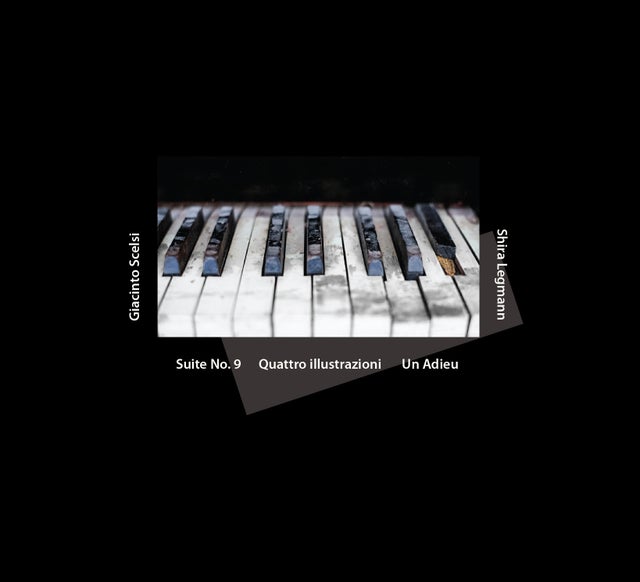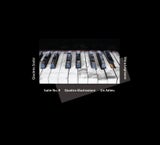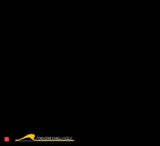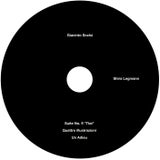- Shira Legmann
- >
- Shira Legmann - Giacinto Scelsi: Suite No.9 / Quattro illustrazioni / Un Adieu (CD)
Shira Legmann - Giacinto Scelsi: Suite No.9 / Quattro illustrazioni / Un Adieu (CD)
SKU:
$14.00
$14.00
Unavailable
per item
elsewhere 013
This album contains three piano works by Italian composer Giacinto Scelsi's: 'Suite No.9 "Ttai"' (1953), 'Quattro illustrazioni' (1953), and 'Un Adieu' (1978/1988), performed by Israeli concert pianist Shira Legmann.
Four-panel gatefold wallet with one disc, cover photo by David Sylvian, design by Yuko Zama.
For lossless AIFF (16/44) file, go to this page.
For digital HD FLAC (24/96), go to this page.
*Streaming only available on Bandcamp.
|
TRACK INFO
1-9. Suite No.9 "Ttai" (1953) "a succession of episodes which alternatively express time - or more precisely, time in motion and man as symbolized by cathedrals or monasteries, with the sound of the sacred 'Om'" (Giacinto Scelsi) I. Calmo, senza espressione II. Lentissimo III. Uguale, senza espressione IV. Non molto legato, ma sempre appoggiando profondamente V. Uguale, scorrevole VI. Lento VII. Uguale, inespressivo VIII. Lento IX. Molto p eguale, non troppo legato 10-13. Quattro illustrazioni (1953) “four illustrations of the metamorphoses of Vishnu” I. SHÉSHA - SHÀYÍ VISHNU II. VARAHA - AVATÀRA III. RAMA - AVATÀRA IV. KRISHNA - AVATÀRA 14. Un Adieu (1978/1988) (release date: November 11, 2020) CREDITS
compositions by Giacinto Scelsi (1905-1988) Shira Legmann - piano Suite No.9 "Ttai" - live concert, recorded and mixed by Itzik Mizrahi at Clairmont Concert Hall, Tel Aviv - Jaffa, December 9, 2014 Quattro illustrazioni - live concert, recorded and mixed by Ronald Boersen at HaTeiva, Tel Aviv - Jaffa, February 27, 2014 Un Adieu - recorded by Rafi Eshel at the Buchmann-Mehta School of Music, Tel Aviv - Jaffa, June 19, 2020, mixed by Taku Unami mastered by Taku Unami photography by David Sylvian design by Yuko Zama produced by Yuko Zama special thanks to: Fondazione Isabella Scelsi p+c 2020 elsewhere music www.elsewheremusic.net |
Shira Legmann is an Israeli concert pianist, with a wide repertoire from Baroque to contemporary and experimental music. This album contains three piano works by Italian composer Giacinto Scelsi's: 'Suite No.9 "Ttai"' (1953), 'Quattro illustrazioni' (1953), and 'Un Adieu' (1978/1988). 'Suite No.9' and 'Quattro illustrazioni' were recorded live at two different concerts in 2014, while 'Un Adieu' was recently recorded in a studio in June 2020. This is Legmann's second CD on Elsewhere Music, following the 2019 album 'Barricades' in which she was the pianist for Michael Pisaro's composition for piano/electronics.
"Scelsi's music is something that 'grows' on us both as listeners and musicians. When I first discovered his music about ten years ago, I just dove into studying it, and the connection grew slowly while getting into more and more nuances in the playing. For a few years, I've been fascinated by these three pieces, and have performed them in Israel. It was not an immediate 'crush' but something that has gradually matured in me." “Scelsi was said to be a modest artist. He believed that as a composer, he is merely a mediator. For a substantial period, he composed his piano pieces by improvising: he conceptualized them and then improvised while recording. Later, with the help of friends and assistants, he notated from the recordings and that was his written composition. Since these compositions derive directly from improvisations, I felt the best representation of them would be as recordings of live performances, where there is also an element of risk, surprise, and spirit." (Shira Legmann) "A whole chapter of recent musical history must be rewritten: the second half of this century is now unthinkable without Scelsi... He has inaugurated a completely new way of making music, hitherto unknown in the West." (Harry Halbreich) Legmann's clean, supple yet solid piano sounds, which create a perfect balance of coolness and warmth, build a narrative flow with a stunning dynamic range, bringing these rarely performed piano works of Scelsi's back to life into the twenty-first century as timeless masterpieces. The cover photograph was taken by David Sylvian. The desolate image of abandoned old piano keys echoes the mysterious Zen silence and discreet yet profound beauty of Scelsi's piano works. https://www.shiralegmann.com > Shira Legmann Interview about Scelsi's piano works REVIEWS
Peter Margasak, Daily Bandcamp Israeli pianist Shira Legmann has demonstrated a wide-open aesthetic in recent years, previously recording for the Elsewhere imprint on a performance of Michael Pisaro’s album Barricades, which she followed with an impressive self-released recording of Bach’s Partitas 1, 3, and 4. This new collection is devoted to works by the enigmatic Italian composer Giacinto Scelsi. He developed his pieces through improvisation and often recorded his work to tape and instructed his assistants to transcribe the performances. This practice injected an additional layer of uncertainty into his scores, some of which, like the nine wending movements of “Suite No. 9,” were written without a fixed tempo. That innate volatility convinced Legmann to record most of this languorous album live in concert rather than in a studio. In the press materials for the album she credits the composer with sharpening her focus as a musician: “Taking the freedom in shaping a musical syntax, for example in Bach, Haydn, or Feldman’s music, while respecting their written score, became my main focus and interest as an interpreter.” Indeed, she deftly inhabits these mercurial pieces, especially on the opening work, of which the composer said, “This suite should be listened to and played with the greatest inner calm. Nervous people stay away!” But these performances are hardly placid even if they are meticulously pitched, rife with a churning kind of ebb-and-flow between agitation and serenity. (10/26/2020) Michele Palozzo, Esoteros Every valuable listening should be, in its own way, dedicated. Even for the most assiduous music lover, the temptation and the opportunities to get distracted are always around the corner: yet, in some cases, music itself is the antidote raising the threshold of attention, the magnetic force that makes us regain consciousness and even seems to push us beyond its limits. And if, on the one hand, the entire editorial line of Yuko Zama’s Elsewhere represents an exhortation – if not an actual education – to deep listening, so too Giacinto Scelsi’s mystical and unclassifiable oeuvre is able to exert each time its own uncanny form of seduction, unhinging any sense of familiarity to access a dimension of absolute formal and expressive alterity. The three pieces selected for this collection are just a few testimonies of a history of piano literature “forgotten by heart”: an inspiration absorbing the energies and the marked pathos of the classical age by osmosis to transfer them into scores apparently extraneous to any canon, ideally placed in a liminal and uncontaminated space between the long wave of late romanticism and the integralism of post-Webern avantgarde. With a similar disposition to oblivion, to the “lucid passivity” professed by the Italian composer, both the interpreter and the listener should approach these pieces: inviting silence and absorption, clear-mindedly entering the spirit of Scelsi’s visionary and totalizing improvisations, whose subsequent transcription on paper would later on be reclaimed by collaborator Vieri Tosatti. The medium of this “channeling” is the talented Israeli Shira Legmann, already protagonist on Elsewhere of the first recording of “Barricades” (2018-2019), Michael Pisaro’s cycle of electroacoustic etudes, but who also proved to be equally in tune with Bach’s Partitas for harpsichord, which became famous in the piano versions by Glenn Gould. And although the imperfect sound grain of the live recording is distinctly perceived, the effort of transference and the overwhelming passion of Legmann’s renditions are not affected in the least, ensuring a listening experience of rare emotional power. The album’s main piece is the “Suite No.9” (1953), further identified with the word “Ttai”: it’s the eleventh hexagram of the I-Ching, the Chinese ‘Book of changes’ which John Cage, in that same period, began to use as a method of divination for his aleatory scores. “The little one goes, the big one comes. Heaven and Earth unite, the image of Peace”, reads the oriental text in response to the random toss of the coins, as if to tell us that in the transient flow of existence one can always experience times of relative prosperity, a favorable resolution which often, however, must pass through a necessary destabilization, the unexpected upheaval of one’s own certainties. This would explain, in fact, the decidedly heavy mood of these nine movements, capable of reconciling the fury of the elements with a pensive and tormented lyricism: it’s the swashing of an interiority inexpressible if not by the abstraction of the notes, vehemently entwined or overlapped within small intervals, with sporadic encroachments into the upper register which evoke the tolling of bells, sometimes lulling, other times abrupt and searing. The dramatic outbursts flowing from Scelsi’s hands exhibit, in several cases, surprising assonances with György Ligeti’s “Musica Ricercata” – coeval with the Suite but first performed in public only in 1969 –, a programmatic exercise in style taking cue from just two notes, progressively added up until the twelve of its last segment. The darkly obsessive character of the suite is propagated, with less afflatus, in the following “Quattro illustrazioni” (‘Four illustrations’): also dated to 1953, they refer to the Metamorphoses (or avatāra) of the Hindu divinity Vishnu, as described in the Bhagavadgītā. By lingering on the different and nervous repetition of motivic figures comparable to mantras, in just under fifteen minutes peaks are reached of violent and transforming ecstasy – relived by Legmann with formidable enthusiasm –, to finally sink into a vortex of abysmal irresolution. It’s the uncorrupted fruit of a meditative state capable of evading any conscious will, solely transpiring the alternating currents of the inscrutable chaos that dwells in the soul of its bodily vessel. Twenty-five years later, “Un Adieu” (1978) seems to constitute its natural epilogue: a fit of nonetheless unquiet melancholy that reveals, in filigree, the shadowy profile of the reclusive Count Scelsi, an outsider by vocation in life and an increasingly cult figure after his death in 1988. His influence on contemporary music is by now undeniable, as well as transversal, and this also thanks to the commitment of independent labels (no longer only European) who didn’t fail to recognize the singularity of his transcendental poetics. (11/14/2020) Bill Meyer, Chicago Reader The music that Italian composer Giacinto Scelsi wrote during the middle of the 20th century predicted minimalism and spectralism, but its forms and sounds remain distinct from those later developments—and from most other European classical music. Born in 1905, he started composing music in the late 1920s and arrived at his mature style after experiencing a catastrophic emotional breakdown in the Iate 1940s. Unable to benefit from available psychiatric treatment, he recovered following lengthy episodes of playing single notes on the piano, which led him to shed 12-tone composition and other complex forms in order to engage directly with pure sound. Each movement of his best-known work, Quattro Pezzi su una Nota Sola (1959), uses just one note, though it’s scored for a 26-member chamber orchestra—he creates variety with groupings of players in unisons and octaves, shifts in dynamics and timbre, microtonal fluctuations, and other techniques. Scelsi composed the two suites for solo piano that make up the bulk of this new CD during his “second period” of writing (from 1952 till 1959), and each expresses his interest in Eastern spiritual practices without resorting to direct quotes from Chinese or Indian musical styles. On Suite No. 9 “Ttai” (1953), which lasts more than half an hour, resonance and repetition extract om-like approximations of continuous sound from small handfuls of notes. The more compact Quattro Illustrazioni (1953), which depicts the metamorphoses of Vishnu, is similarly economic but more dynamic, building to bold crescendos during the second section, “Varanda Avatara,” and letting harsh tone clusters decay during the fourth part, “Krishna Avatara.” Israeli pianist Shira Legmann sustains complementary focuses upon the micro and macro dimensions of these pieces, using continuous, minute differentiation of attack to enrich discrete passages while maintaining firm control over each composition’s narrative arc. The album closes with Un Adieu (1978-1988), one of Scelsi’s final works. First performed at his funeral in 1988, it distills the materials of its predecessors into a mournful but unbowed articulation of loss. (11/30/2020) John Eyles, All About Jazz Although the German-born Israeli pianist Shira Legmann is also an interdisciplinary artist who creates new compositions and soundtracks based on graphic novels, animation and video art, having collaborated with artists from the fields of plastic art, dance and design, she is best known as a concert pianist who frequently performs in Europe, Israel and USA. To date, it is this side of Legmann which has been showcased on Elsewhere. Legmann has a broad repertoire stretching from Baroque to contemporary composition as exemplified by her first Elsewhere release with Pisaro and this one featuring three compositions by the underrated but influential Italian Giacinto Scelsi (1905-1988). On live concert recordings, dating from 2014, in Tel Aviv, Legmann plays two extended Scelsi compositions from 1953—near the start of his so-called second period—the nine-part "Suite No.9 'Ttai' " and the four-part "Quattro illustrazioni." These pieces are tailor-made to highlight Legmann's talent as a pianist; while technically perfect, her playing invariably gets the emotional temperature just right and eloquently conveys their stories. Anyone unfamiliar with Scelsi would be well advised to make this their starting point. Fittingly, the album concludes with the shorter "Un Adieu" recorded in Tel Aviv, in June 2020, Legmann once again getting under the skin of the piece and capturing its mood perfectly. Beguiling as she is playing other composers' pieces, some time soon it would be good to hear some of Legmann's own. Next time maybe? Until then, this album will do very nicely, thank you. (10/30/2020) Eyal Hareuveni, The Free Jazz Collective Israeli pianist Shira Legmann dedicates her second album for the elsewhere label (following her collaboration with composer Michael Pisaro, Barricades, 2019) to the Italian eccentric composer Giacinto Scelsi (1905-1988). She explains her fascination with Scelsi music with “his unique syntax of musical phrases, and the freedom he allows for the pianist in shaping them. By using minimal thematic materials and small shifts of articulation, all in a free time-signature environment, Scelsi offers a platform for the pianist to play with gravity points, resulting in the internal logic of syntax and meaning”. Legmann performs three compositions of Scelsi. These compositions derive from improvisations - as Scelsi saw himself as a medium who received musical messages while meditating and improvising. These diverse compositions were recorded live in Tel Aviv in 2014 and 2019, “where there is also an element of risk, surprise and spirit”. David Sylvian contributed the cover photograph, echoing the mystic and profound beauty of Scelsi's piano works. The first composition is the nine-movements “Suite No.9” (1953), titled also as “Ttai”, after the eleventh hexagram of the ancient Chinese book of divination, I-Ching (“The little one goes, the big one comes. Heaven and Earth unite, the image of Peace”. John Cage also used this book for compositional decisions). Scelsi described this composition as "a succession of episodes which alternatively express time - or more precisely, time in motion and man as symbolized by cathedrals or monasteries, with the sound of the sacred 'Om'", and advised that this suite should be “listened to and played with the greatest inner calm. Nervous people stay away!”. Legmann captures beautifully the mystical and enigmatic world of Scelsi, himself a Zen Buddhist, including the recurring attempt to balance between emotional turmoil and poetic peacefulness. The second composition, the four-movements “Quattro illustrazioni” (Four illustrations) (1953), is more dramatic and at times even chaotic, referring to the four illustrations of the metamorphoses of the Hindu deity Vishnu, as described in the Bhagavadgītā. Legmann enjoys exploring the ecstatic and sensual storms and the freedom to celebrate the full sonic spectrum of the piano. The last and short “Un Adieu” (1978/1988), considered as Scelsi’s last composition, is a meditative and melancholic piece, described by Lehmann as “a funeral march” where “the music asks the pianist to keep walking and not look back”. Remarkable work. (12/19/2020) |




